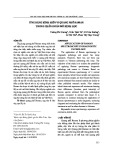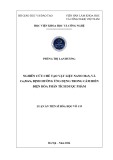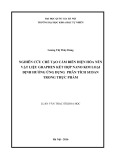
TNU Journal of Science and Technology
230(02): 97 - 105
http://jst.tnu.edu.vn 97 Email: jst@tnu.edu.vn
THE FABRICATION OF NON-ENZYMATIC GRAPHENE/ITO SENSOR BY
ELECTROPHORETIC DEPOSITION FOR URIC ACID DETECTION
Trinh Ngoc Hien1,2, Dang Van Thanh2,3, Nguyen Xuan Hoa3,
Nguyen Van Dang2,4, Nguyen Quoc Dung5, Pham Van Hao1*
1TNU - University of Information and Communication Technology
2Graduate University of Science and Technology - Vietnam Academy of Science and Technology
3TNU - University of Medicine and Pharmacy, 4TNU - University of Sciences, 5TNU - University of Education
ARTICLE INFO
ABSTRACT
Received:
07/12/2024
This report presented the results on the fabrication of a modified
Graphene/ITO electrode using the electrophoretic deposition method of
graphene onto an ITO substrate which was applied as a non-enzymatic
sensor for uric acid detection. The morphology and structure of graphene
as well as Graphene/ITO were characterized by scanning electron
microscopy and Raman spectroscopy. The electrochemical properties
were investigated to assess the material's potential applications. The
results of the electrochemical response to different concentrations,
analyzed using the differential pulse voltammetry method, demonstrates
that the fabricated sensor exhibits linearity and sensitivity in two
respective ranges: the first range from 10–100 µM (R² = 0.99763) with a
corresponding sensitivity of 0.22094 (µAcm⁻²µM⁻¹); the second linear
range from 100–2000 µM (R² = 0.99617) with a corresponding
sensitivity of 0.05462 (µAcm⁻²µM⁻¹). These results suggested the
potential applications would be significant in biochemical examination.
Revised:
17/02/2025
Published:
17/02/2025
KEYWORDS
Graphene
Graphite
Electrochemical sensor
Uric acid
Electrophoretic deposition
CHẾ TẠO CẢM BIẾN KHÔNG ENZYME GRAPHENE/ITO
BẰNG PHƢƠNG PHÁP LẮNG ĐỌNG ĐIỆN DI XÁC ĐỊNH AXIT URIC
Trịnh Ngọc Hiến1,2, Đặng Văn Thành2,3, Nguyễn Xuân Hòa3,
Nguyễn Văn Đăng2,4, Nguyễn Quốc Dũng5, Phạm Văn Hảo1*
1Trường Đại học Công nghệ Thông tin và Truyền thông – ĐH Thái Nguyên
2Học viện Khoa học và Công nghệ - Viện Hàn lâm Khoa học và Công nghệ Việt Nam
3Trường Đại học Y Dược – ĐH Thái Nguyên, 4Trường Đại học Khoa học – ĐH Thái Nguyên,
5Trường Đại học Sư phạm – ĐH Thái Nguyên
THÔNG TIN BÀI BÁO
TÓM TẮT
Ngày nhận bài:
07/12/2024
Bài báo này trình bày kết quả chế tạo điện cực biến tính Graphene/ITO
bằng phương pháp lắng đọng điện di graphene lên đế ITO, ứng dụng
làm cảm biến không enzyme xác định axit uric. Hình thái và cấu trúc
của graphene cũng như Graphene/ITO được mô tả bằng kính hiển vi
điện tử quét và quang phổ Raman. Đặc trưng điện hóa được khảo sát để
đánh giá tiềm năng ứng dụng của vật liệu. Các kết quả cho thấy cảm
biến chế tạo có phạm vi tuyến tính và độ nhạy với hai khoảng tương
ứng là: khoảng thứ nhất có nồng độ từ 10–100 µM (R2 = 0,99763), độ
nhạy tương ứng là 0,22094 (µAcm–2µM–1); khoảng tuyến tính thứ hai từ
100–2000 µM (R2 = 0,99617), độ nhạy tương ứng là 0,05462 (µAcm–
2µM–1). Kết quả này gợi mở nhiều tiềm năng ứng dụng trong các xét
nghiệm sinh hóa.
Ngày hoàn thiện:
17/02/2025
Ngày đăng:
17/02/2025
TỪ KHÓA
Graphene
Graphite
Cảm biến điện hóa
Axit Uric
Lắng đọng điện di
DOI: https://doi.org/10.34238/tnu-jst.11663
* Corresponding author. Email: pvhao@ictu.edu.vn

























